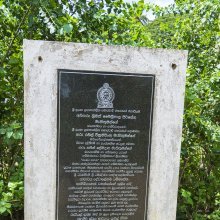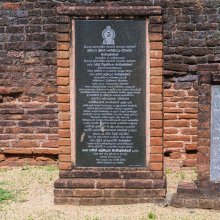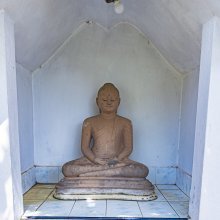Nivasa, Nivāsa, Nivasha: 18 definitions
Introduction:
Nivasa means something in Hinduism, Sanskrit, Buddhism, Pali, Marathi, Jainism, Prakrit, Hindi. If you want to know the exact meaning, history, etymology or English translation of this term then check out the descriptions on this page. Add your comment or reference to a book if you want to contribute to this summary article.
Images (photo gallery)
In Hinduism
Purana and Itihasa (epic history)
Source: archive.org: Shiva Purana - English TranslationNivāsa (निवास) refers to “abodes for the residence (of the Gods)”, according to the Śivapurāṇa 2.3.38 (“Description of the dais or maṇḍapa”).—Accordingly, as Himavat prepared the wedding of Menā and Śiva: “[...] O celestial sage, of what avail is a long-drawn description? The gods were drawn by Viśvakarman as desired by Himavat. The Altar was erected by him with wonderful features, fascinating the gods and exquisite in form. On being commanded by the lord of mountains, the intelligent Viśvakarman created different abodes for the residence (nivāsa) of the gods and others. Great couches of wonderful brilliance very cosy and exquisite were made by Viśvakarman for their sake. [...]”.

The Purana (पुराण, purāṇas) refers to Sanskrit literature preserving ancient India’s vast cultural history, including historical legends, religious ceremonies, various arts and sciences. The eighteen mahapuranas total over 400,000 shlokas (metrical couplets) and date to at least several centuries BCE.
Languages of India and abroad
Pali-English dictionary
Source: BuddhaSasana: Concise Pali-English Dictionarynivāsa : (m.) abode; resting place; living.
Source: Sutta: The Pali Text Society's Pali-English DictionaryNivāsa, (fr. nivasati2) stopping, dwelling, resting-place, abode; living, sheltering J. I, 115 (°ṃ kappeti to put up); II, 110; PvA. 76, 78. Usually in phrase pubbe-nivāsaṃ anussarati “to remember one’s former abode or place of existence (in a former life), ” characterising the faculty of remembering one’s former birth D. I, 13, 15, 16, 81; S. I, 167, 175, 196; II, 122, 213; V, 265, 305; A. I, 25, 164; II, 183; III, 323, 418 sq.; IV, 141 sq.; V, 211, 339. Also in pubbenivāsaṃ vedi It. 100; Sn. 647=Dh. 423; p-n-paṭisaṃyuttā dhammikathā D. II, 1; p-n-anussatiñāṇa D. III, 110, 220, 275; A. IV, 177. Cp. nevāsika. (Page 372)

Pali is the language of the Tipiṭaka, which is the sacred canon of Theravāda Buddhism and contains much of the Buddha’s speech. Closeley related to Sanskrit, both languages are used interchangeably between religions.
Marathi-English dictionary
Source: DDSA: The Molesworth Marathi and English Dictionarynivāsa (निवास).—m S An abode, residence, or dwelling-place. 2 Residence, dwelling, abiding.
Source: DDSA: The Aryabhusan school dictionary, Marathi-Englishnivāsa (निवास).—m An abode, residence.
Marathi is an Indo-European language having over 70 million native speakers people in (predominantly) Maharashtra India. Marathi, like many other Indo-Aryan languages, evolved from early forms of Prakrit, which itself is a subset of Sanskrit, one of the most ancient languages of the world.
Sanskrit dictionary
Source: DDSA: The practical Sanskrit-English dictionaryNivāsa (निवास).—
1) Living, dwelling, residing.
2) A house, adode, habitation, resting-place; निवासश्चिन्तायाः (nivāsaścintāyāḥ) Mṛcchakaṭika 1.15; Śiśupālavadha 4.63;5.21; Bhagavadgītā (Bombay) 9.18; Mṛcchakaṭika 3.23.
3) Passing the night.
4) A dress, garment.
5) Nightquarters.
6) Refuge, receptacle, asylum; जगन्निवासो वसुदेवसद्मनि (jagannivāso vasudevasadmani) Śiśupālavadha 1.1.
Derivable forms: nivāsaḥ (निवासः).
Source: Cologne Digital Sanskrit Dictionaries: Edgerton Buddhist Hybrid Sanskrit DictionaryNivāsa (निवास).—m. (= Pali id.), (former) state of existence; usually in cpds. pūrva-(pūrve-)ni°, qq.v.; with separation of the [compound], pūrve (so all mss., Senart em. °vaṃ) ca nivāsa- vāraṃ (time, turn) Mahāvastu i.4.8; rarely otherwise, nivāsānut- tarya-saṃpanna Mahāvastu iii.320.5 (see anuttarya), perfect in the supreme excellence of (former) births. See also s.v. pūrve-vāsa.
Source: Cologne Digital Sanskrit Dictionaries: Shabda-Sagara Sanskrit-English DictionaryNivāsa (निवास).—m.
(-saḥ) 1. A house, a dwelling. 2. Passing the night. E. ni in, vas to abide, aff. ādhāre ghañ .
Source: Cologne Digital Sanskrit Dictionaries: Benfey Sanskrit-English DictionaryNivāsa (निवास).—i. e. ni-vas + a, m. 1. Dwelling, [Rāmāyaṇa] 3, 5, 22. 2. Passing the night, [Harivaṃśa, (ed. Calc.)] 9700. 3. An abode, a house, [Bhāgavata-Purāṇa, (ed. Burnouf.)] 1, 11, 27. 4. Nightquarters, [Rāmāyaṇa] 2, 55, 33. 5. Cloth, [Harivaṃśa, (ed. Calc.)] 10679.
Source: Cologne Digital Sanskrit Dictionaries: Cappeller Sanskrit-English DictionaryNivāsa (निवास).—1. [masculine] clothing; [adjective] clothed in (—°).
--- OR ---
Nivāsa (निवास).—2. [masculine] stopping, dwelling; resting-place, abode, home.
Source: Cologne Digital Sanskrit Dictionaries: Monier-Williams Sanskrit-English Dictionary1) Nivāsa (निवास):—[=ni-vāsa] [from ni-vas] a m. clothing, dress (ifc. = [preceding]), [Harivaṃśa]
2) [=ni-vāsa] [from ni-vas] b m. living, dwelling, residing, passing the night
3) [v.s. ...] dwelling-place, abode, house, habitation, night-quarters, [Mahābhārata; Rāmāyaṇa] etc.
4) Nivāśa (निवाश):—[=ni-vāśa] mfn. (√vāś) roaring, thundering, [Atharva-veda]
Source: Cologne Digital Sanskrit Dictionaries: Yates Sanskrit-English DictionaryNivāsa (निवास):—[ni-vāsa] (saḥ) 1. m. A house.
Source: DDSA: Paia-sadda-mahannavo; a comprehensive Prakrit Hindi dictionary (S)Nivāsa (निवास) in the Sanskrit language is related to the Prakrit word: Ṇivāsa.
[Sanskrit to German]
Sanskrit, also spelled संस्कृतम् (saṃskṛtam), is an ancient language of India commonly seen as the grandmother of the Indo-European language family (even English!). Closely allied with Prakrit and Pali, Sanskrit is more exhaustive in both grammar and terms and has the most extensive collection of literature in the world, greatly surpassing its sister-languages Greek and Latin.
Hindi dictionary
Source: DDSA: A practical Hindi-English dictionaryNivāsa (निवास) [Also spelled nivas]:—(nm) residence, abode, habitation, lodging, dwelling; -[sthala] quarter, habitat; -[sthāna] house, residence.
...
Prakrit-English dictionary
Source: DDSA: Paia-sadda-mahannavo; a comprehensive Prakrit Hindi dictionary1) Ṇivasa (णिवस) in the Prakrit language is related to the Sanskrit word: Nivas.
2) Ṇivāsa (णिवास) also relates to the Sanskrit word: Nivāsa.
Prakrit is an ancient language closely associated with both Pali and Sanskrit. Jain literature is often composed in this language or sub-dialects, such as the Agamas and their commentaries which are written in Ardhamagadhi and Maharashtri Prakrit. The earliest extant texts can be dated to as early as the 4th century BCE although core portions might be older.
Kannada-English dictionary
Source: Alar: Kannada-English corpusNivasa (ನಿವಸ):—[noun] a building where one lives in; a house.
--- OR ---
Nivāsa (ನಿವಾಸ):—
1) [noun] a building in which people live; residence for human beings; a house.
2) [noun] a place as nest, den, etc. where birds, animals take shelter.
3) [noun] the place or region where something is native or most common; a home.
Kannada is a Dravidian language (as opposed to the Indo-European language family) mainly spoken in the southwestern region of India.
See also (Relevant definitions)
Partial matches: Vasa, Vaca, Ni.
Starts with (+4): Nivacam, Nivacati, Nivasa-m, Nivasabhavana, Nivasabhumi, Nivasabhuya, Nivasacarya, Nivasaka, Nivasana, Nivasani, Nivasanta, Nivasanti, Nivasanusmriti, Nivasaracana, Nivasarachana, Nivasarajan, Nivasasthana, Nivasat, Nivasata, Nivasatha.
Ends with (+31): Adhikritanivasa, Ahinivasa, Akutobhayanivasa, Anivasa, Aryanivasa, Badhula shrinivasa, Chidranivasa, Dharmanivasa, Dvitridivasanivasa, Dyunivasa, Garbhanivasa, Jaganivasa, Jagannivasa, Jannivasa, Jayashrinivasa, Kashmirikanivasa, Kelinivasa, Kshamadharanivasa, Kukshinivasa, Kvanivasa.
Full-text (+70): Shrinivasa, Dyunivasa, Nivasaka, Nivas, Vrikshanivasa, Yadonivasas, Nivasabhuya, Nivasabhavana, Nivasaracana, Jagannivasa, Nivasin, Kvanivasa, Naivasika, Nivasabhumi, Sannivasa, Nivasarajan, Nivasavriksha, Nivasata, Nivasasthana, Shrinivasadikshitiya.
Relevant text
Search found 27 books and stories containing Nivasa, Ni-vasa, Ni-vāsa, Ni-vāśa, Ni-vasha, Nivāsa, Nivāśa, Ṇivasa, Ṇivāsa, Nivasha; (plurals include: Nivasas, vasas, vāsas, vāśas, vashas, Nivāsas, Nivāśas, Ṇivasas, Ṇivāsas, Nivashas). You can also click to the full overview containing English textual excerpts. Below are direct links for the most relevant articles:
Garga Samhita (English) (by Danavir Goswami)
Verse 6.21.12 < [Chapter 21 - In the Description of the Third Fort, the Glories of Piṇḍāraka-tīrtha]
Verse 6.21.30 < [Chapter 21 - In the Description of the Third Fort, the Glories of Piṇḍāraka-tīrtha]
Verse 8.13.31 < [Chapter 13 - A Thousand Names of Lord Balarāma]
Hari-bhakti-kalpa-latikā (by Sarasvati Thkura)
Text 1 < [First Stabaka]
Brihad Bhagavatamrita (commentary) (by Śrī Śrīmad Bhaktivedānta Nārāyana Gosvāmī Mahārāja)
Verse 2.4.87 < [Chapter 4 - Vaikuṇṭha (the spiritual world)]
Verse 2.3.64 < [Chapter 3 - Bhajana (loving service)]
Verse 1.6.49 < [Chapter 6 - Priyatama (the most beloved devotees)]
Shrimad Bhagavad-gita (by Narayana Gosvami)
Verse 11.25 < [Chapter 11 - Viśvarūpa-darśana-yoga (beholding the Lord’s Universal Form)]
Verses 9.16-19 < [Chapter 9 - Rāja-guhya-yoga (Yoga through the most Confidential Knowledge)]
Verse 11.45 < [Chapter 11 - Viśvarūpa-darśana-yoga (beholding the Lord’s Universal Form)]
Tattvartha Sutra (with commentary) (by Vijay K. Jain)
Verse 3.19 - The nymphs (devī) living in lotuses < [Chapter 3 - The Lower World and the Middle World]
Verse 4.24 - Those who have the Brahmaloka as their abode < [Chapter 4 - The Celestial Beings]
Verse 7.6 - The observances for the vow of non-stealing (acaurya) < [Chapter 7 - The Five Vows]
Rig Veda (translation and commentary) (by H. H. Wilson)


